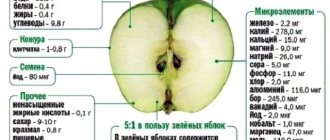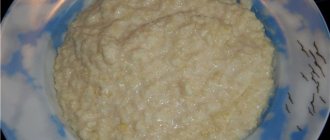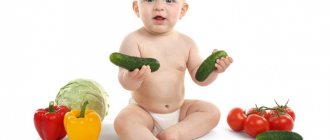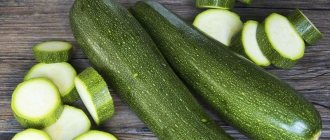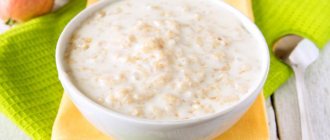Fruit purees for infants are introduced into the first complementary foods at the age of 6-7 months. Apple, banana and pear are great for this. These fruits are very healthy and less allergenic. In addition, they are easily absorbed and digested and do not disturb digestion and stool.
In the first weeks of complementary feeding, fruit puree should consist of one component. You can find detailed rules for complementary feeding here, and in this article we will learn a recipe for pear puree for babies. Let's consider how this fruit is useful for babies, and at what age this food can be given.
Pear puree is a rich source of vitamins and minerals
Pear is not only the most delicious, but also a healthy fruit. Pear fruits, rich in vitamins and minerals, included in the children's diet, help the child's body grow and develop properly.
The pureed fruits of this fruit do not lose their beneficial properties - just like whole pears, they contain the most useful and necessary elements for the child’s body in the form of:
- water-soluble vitamin B complexes, ascorbic and nicotinic acids;
- lipophilic vitamins – phylloquinones, retinols, tocopherols;
- folic acid;
- pectins, some orderlies of the body that absorb toxins;
- fiber;
- mineral salts and tannins.
Such a rich saturation of useful substances and vitamins allows the fruit to normalize the digestive process in the baby and, in the early stages of his life, act as a building material at the intracellular and intercellular level.
Also, the described fruits can act as a laxative and help the baby, if necessary, cope with constipation.
Baked Pears with Oatmeal and Dates (8 months+)
You will need:
3 pears, 1 cup cooked oatmeal, ½ cup finely chopped dates, a little maple syrup (optional), a pinch of cinnamon, vanilla or ginger.
Preparation:
1. Cut the pears in half, remove the middle.
2. Mix the oats, dates and spices with water, bring to a boil, and then simmer until the mixture has a soup-like consistency.
3. After this, pour the resulting “soup” over the pears and bake in the oven at 180°C for 45 minutes, or until the pears are soft. Add a few drops of maple syrup if desired.
When can you introduce pear puree into your baby's complementary foods?
It is possible to introduce the first complementary food for a baby in the form of pear puree, especially if the baby is breastfed, from 5-6 months. If the child is “artificial”2, then it will be more advisable to diversify his diet with pear puree from the age of 4 months.
Important! Nutritionists recommend starting the first complementary foods, starting with vegetable puree, and only then giving the baby a mixture of fruits so that he understands and feels all the taste qualities, for example, an apple or a pear.
In addition, according to numerous advice from mothers, the described puree can be replaced with pear juice, which is beneficial for infants from 5 months.
Also, this fruit, cut into large pieces, will not harm the child. In the old fashioned way, a pear slice can be wrapped directly in a piece of gauze for the baby and given instead of a pacifier.
Choosing pears for children to get acquainted with
Today, there are thousands of varieties of pears, including ornamental and fruit trees. Not all representatives of the many fruit varieties are suitable for preparing fruit complementary foods for an infant.
Juicy soft specimens (Conference, Summer Williams (Duchess), Grand Champion, Komis) are best suited for baby food. A wonderful dish with a sweet and sour or dessert flavor is obtained from ripened fruits with green skin without a pink blush and with melting pulp.
The main thing is to prepare it for your baby, preserving the maximum amount of nutrients in the pear.
At what months should you start introducing it into your diet?
A positive reaction to adding a pear to an infant’s diet is manifested in the case of careful and careful testing of the described puree and if the parents observe the following rules:
- By including pear puree in the menu, after vegetables and apples were previously introduced into the baby’s diet, feeding a breastfed baby should be done no earlier than six months of age. Children who are bottle-fed are allowed to eat pear treats when they reach 4 months of age.
- For a baby, a new product in the form of pear puree should not exceed 15 grams in weight at first; portions can be increased over time.
- When a baby is one year old, he is allowed to eat 100 grams of puree made from fruit.
- The pear used to prepare fruit türi must be heat treated and then crushed using a sieve or blender.
- Before cooking or serving the child whole, the fruit must be thoroughly washed and scalded with boiling water.
You can prepare pear puree using a double boiler, multicooker, microwave, or oven. The selection of the most suitable option for preparing fruit puree is carried out directly by the parents.
What is important to know and do?
An important condition for introducing pear complementary foods is compliance with the following rules.
- The baby must be at least 6 months old.
- The child must be absolutely healthy.
- The child's body should already have experience in eating pureed vegetables.
- Pears should only be given pureed.
- The first acquaintance with a pear is to use no more than 1 teaspoon of puree.
- The baby's consumption of pear complementary foods should be gradually increased.
To maximize the digestibility of the fruit, nutritionists recommend using pears in the children's menu that grew in the same area where the family and the child live. A pear “from a neighboring country house” is much healthier than a glossy fruit from far abroad. But despite this, fruits should still be washed thoroughly.
Important!
There is no escape from the environmental situation, so it is important to remember that all harmful substances accumulate in the peel of the fruit. For this purpose, when preparing puree, pear fruits should be peeled.
How to prepare pear puree - recipes
It is necessary to prepare pear stew from sweet and juicy fruits of a homogeneous mass with green peel. Due to the baby’s excessive sensitivity to infection, any fruit, including pears, should be washed with a brush. The described fruit must be doused with boiling water, and then thoroughly wiped with a paper towel.
Next, the pear must be peeled, seeds, and hard veins of pulp. After the fruit is divided into small pieces, you need to put it in a pan and pour water on top. Cook the pear for no more than 15 minutes over medium heat. The readiness of the product is determined by the type of fruit - it should soften.
At the end of cooking, the resulting mixture must be cooled, crushed using a blender and served to the baby.
Pear puree prepared in a slow cooker
Pear puree in a slow cooker is prepared in stages:
- the fruits are washed, scalded with boiling water, the skin and seeds are removed;
- pieces of pear cut into slices are placed on a special baking sheet for steaming;
- then the multicooker container is filled with 700 milliliters of water, and a baking tray with fruit is placed on top;
- set the mode - “cooking using steam” and a time period of a quarter of an hour;
- At the end of cooking, the softened fruits are removed from the multicooker and pureed using a blender.
If the baby liked pear puree and had no problems with the gastrointestinal tract, you can safely switch the child to fresh grated fruit.
In what form should it be given?
The baby's sensitive stomach is not ready for fresh pear, which can cause constipation or diarrhea. If the child has not eaten this fruit before, it is necessary to prepare a puree. It is prepared from boiled or baked pear. Pear puree for babies:
Roasted pear puree. To prepare fruit puree from baked pears, you need to remove the core from the washed fruit with a knife. Place the prepared pear in a preheated oven for 15 minutes. When the baked fruit has cooled, remove the pulp with a spoon and mash it into a puree before giving it to your baby.
When baked in a pear, the amount of substances that cause allergies is significantly reduced, so such complementary foods can even be included in the diet of a child who suffers from diathesis.
Boiled pear puree. You can also boil a pear to make puree. Wash the pear, remove the skin and seeds, cut the pulp into small cubes. Place in a small saucepan and add water. There should be enough of it so that the pear is just covered with liquid. Bring to a boil over low heat and cook for about 7-10 minutes. After this, rub the pear through a sieve or grind it using a blender. If you want to get a softer consistency, you can add a little broth in which the fruit was boiled.
When preparing pear puree, you can add other fruits familiar to your toddler, such as apples.
Recipe for pear puree with apple juice:
Take a pear and freshly squeezed apple juice (~20 ml). Peel the pear and cut into cubes, transfer to a saucepan, add freshly squeezed apple juice. Simmer for about 7 minutes under a closed lid. After that, turn the resulting mass into puree using a blender or mixer. This puree is good to give to your baby warm.
If the child has accepted the boiled pear puree well, you can slowly introduce fresh fruit. To do this, also wash the pear thoroughly, peel and core it, and grate the pulp on a medium grater.
Pears can be present in the diet of babies in another form:
- fruit slices, previously peeled (from 11-12 months);
- pear juice (from 7-8 months);
- compote made from dried fruits (from 6-7 months).
Recipe for making pear puree for baby food
How to introduce it into the diet?
The first acquaintance with the fruit is carried out in the morning so that there is an opportunity to observe the body’s reaction. The first time the baby is given only 0.5 teaspoon of prepared puree. Throughout the day it is necessary to observe the child’s reaction. If there are no allergies or other unpleasant consequences, the pear is given at the fourth feeding.
Babies who are on artificial nutrition are given 30 g of pear puree from 5 months, gradually increasing the portion. By the age of 6 months, the portion can be increased to 60 g. After feeding the pear, the baby is given a mixture.
Children on breastfeeding are given a pear from 6-7 months, starting with 30 g and gradually increasing the portion to 70 g by 8 months.
Artificial babies from 7 months are offered juice (30 ml) at the third feeding. Children who feed on mother's milk are given juice from 8 months.
Tips for choosing
If you are planning to give your baby a pear, choose the fruit carefully. Choose ripe, but not overripe, fruit that is free of rot and damaged areas. The smell will help determine if the pear is ripe. A sweet, pleasant aroma is the best proof of the ripeness of the fruit.
What to do if you have allergies?
If you notice that the child’s body has reacted unfavorably to the pear, the introduction of this fruit should be postponed for a couple of months. If, when you try to give a pear again, the allergy appears again, then you need to exclude the fruit from the menu until the age of 3 or longer, while the allergy persists.
Is it possible to eat pear while breastfeeding?
Young mothers also often wonder whether it is possible to eat pears during breastfeeding; will this harm the baby? Experts recommend that nursing mothers avoid consuming pears, regardless of their variety. This fruit contains a huge amount of fiber. It is believed that this may cause bloating and gas formation. However, in this matter everything is individual. You can try to eat a small amount of this fruit, increasing the dose if the baby does not react in any way to the mother’s diet.
We also read:
- Starting complementary feeding during breastfeeding
- We begin complementary feeding during the period of artificial feeding
Do you want to be the first to read our materials? Subscribe to our telegram channel, Facebook page, or VKontakte group.
We are at Yandex.Zen - join us!
Benefits and possible harm
Due to the content of vitamins and microelements in the pear, the fruit is capable of:
- strengthen the child's immune system;
- improve the digestive system;
- remove harmful substances from the body;
- help the functioning of the cardiovascular and nervous systems;
- improve the child’s mood and vital activity of the body.
The described fruit also has antiseptic, diuretic and antipyretic properties, as well as the ability to fix the baby’s stool.
But it happens that a pear fruit can harm a baby, especially if the baby is diagnosed with diseases such as colitis and gastritis. And even in fresh form, pears can lead to allergic reactions in a child and the development of heaviness in the gastrointestinal tract.
Benefit
The chemical composition of the pear is something different; it turns out that this fruit, familiar to us, contains many vitamins. Pear puree is rich in vitamin A, which has a beneficial effect on the skin and vision. Vitamin “E”, recognized as the beauty vitamin (this is more for you, mommies). Also B vitamins. It has a good effect on the digestive system and cleanses the body of harmful substances.
Pectins and folic acid contained in the composition are very important for the full development of a growing organism.
The minerals in pears include iodine, calcium, manganese, copper, selenium, iron and others. It is also impossible to do without them during the period of growth and development of the baby doll. And, of course, it is also very tasty. Note: In addition to all the above positive properties, pear, or rather compote, can act as an antipyretic.
Pear in a child's diet
Up to six months, infants feed on mother's milk, and only from the age of six months do they begin to get acquainted with new foods. Complementary foods are introduced to bottle-fed babies and children on a mixed diet earlier - from 4 months. Children begin to try food with vegetable and fruit purees.
Mom should know how new complementary foods can affect the baby's health.
Benefit
Pears are rich in nutrients necessary for the development of the baby:
- pectin;
- organic acids;
- carbohydrates;
- vitamins of groups A, B, C, PP;
- zinc, copper, fluorine.
The fruits are well digestible and have a beneficial effect on the child’s body:
- They improve mood and tone due to a large amount of endorphins.
- Normalize the functioning of internal organs.
- Removes nervous tension.
- Boosts immunity, helping fight infections.
A decoction of the fruit lowers body temperature during illness.
Harm
There are negative consequences of eating pears:
- This fruit is contraindicated for gastritis, colitis, and ulcers. A large amount of fiber irritates the walls of the stomach and provokes an exacerbation of the disease.
- An allergy is an infrequent adverse reaction of the body to an eaten fruit.
You should not allow your child to overeat on fruits, even despite all their usefulness.
How does it affect children's stool?
Overripe fruit has a laxative effect and can irritate the walls of the stomach. In some cases, the fruit strengthens, in others it weakens. It is recommended to give your baby a pear for constipation and gastrointestinal disorders, which are accompanied by diarrhea.
How the fruit will act on the intestines (strengthen or weaken) depends on the degree of ripeness of the fruit, its variety and method of preparation.
Possible harm
Pear has gained a reputation as a dietary product with a low incidence of allergies. But this does not exclude unwanted reactions in the baby.
Heaviness in the stomach
A feeling of heaviness occurs when the fruit, rich in organic acids, fructose and fiber, is not consumed correctly. To prevent this condition, nutritionists do not recommend:
- offer a pear to a child on an empty stomach or after feeding a meat dish;
- drink it with cold water, which slows down the digestion process.
Allergy
Pear is on the list of products with low potential allergenicity. True, with a caveat - “green varieties”. It is from the green and yellow fruits that it is recommended to introduce pear complementary foods to children under one year of age.
Heat treatment also reduces the likelihood of allergies - pears are boiled or baked to make puree.
Precautionary measures do not always help. The reason may be:
- heredity, when parents are allergic to fruit;
- cross-reaction between different allergens (for example, apples and pears);
- violation of age recommendations (the child is not yet ready to introduce a new product);
- a false allergy that appears to an already familiar fruit when it is overeated.
Symptoms are often limited to skin manifestations in the form of redness, rash or spots with severe itching. From the gastrointestinal tract, nausea, vomiting, and loose stools may occur. Watery eyes and a runny nose in a child should also alert you.
In such situations, it is necessary to stop feeding pears for 1–2 months, and reintroduction requires consultation with the pediatrician.
A serious danger is posed by swelling of the mucous membranes, leading to difficulty breathing, asthmatic cough, and suffocation. This is a medical emergency.
The best varieties
In baby food, preference is given to sweet and juicy varieties, which are easier to digest.
- Summer representatives: “Lada”, “Oryol beauty”, “prominent”. The tender pulp of the fruit is ideal for both making purees and nibblers. A quarter of a medium-sized pear is placed in the feeding net.
- Early autumn varieties: “Rogneda”, “Bere Moskovskaya”, “Otradnenskaya”, “Autumn Dream”. They enrich juices and compotes with bright taste and aroma.
- Late pears are famous for their long shelf life: “winter bere”, “academic”, “Permyachka”. The pulp contains stony cells - coarse granular inclusions, which disappear as they ripen. These fruits are offered fresh to children older than one year.
The summer variety “Williams” is always popular in baby food. Green or yellow specimens are distinguished by sweet white pulp, an abundance of juice and a delicate aroma.
Easily recognizable by its elongated “conference” bottle shape with a melting consistency and sweet taste. It stores well, without sacrificing sweetness, and is universal in use: for making juices, compotes, purees; consumed fresh as a snack, used in a nibbler.



